Have you ever wondered why some lights seem brighter and last longer? Or why others burn out quickly? If you have, you’re not alone. Many people ask, “What is the difference between LED and light bulb?” This question is important because it helps us make better choices for our homes.
Imagine you just bought a new lamp. You want it to shine bright while saving money. You might see options for LED lights and traditional light bulbs. But which one should you choose? Each type has its own perks and drawbacks.
Did you know that LED lights use up to 80% less energy than regular bulbs? That’s a huge difference! Understanding these choices can change the way you light up your room. Plus, it can be a fun adventure to explore how our modern world uses different kinds of lighting.
So, let’s dive in and uncover what makes these two types of lights unique. By the end, you’ll be ready to light up your space smarter!
What Is The Difference Between Led And Light Bulb?
Understanding The Basics: Led Vs. Traditional Light Bulbs
Light Bulbs Have Been A Staple In Households For Generations, But With The Advent Of Technology, The Introduction Of Led (Light Emitting Diode) Bulbs Has Changed The Lighting Landscape. In This Article, We Will Explore The Key Differences Between Led And Incandescent Light Bulbs, Discussing Their Benefits, Efficiency, Cost, And Environmental Impact.
1. Energy Efficiency
One Of The Most Significant Differences Is Energy Efficiency. Led Lights Utilize A Fraction Of The Energy Compared To Traditional Incandescent Bulbs. An Led Bulb Can Produce The Same Amount Of Light As A 60-Watt Incandescent Bulb While Consuming Only Around 10 Watts. This Efficiency Not Only Leads To Lower Electricity Bills But Also Contributes To Reducing Greenhouse Gas Emissions.
2. Lifespan
Led Lights Are Designed To Last Significantly Longer Than Traditional Light Bulbs. While An Incandescent Bulb May Have A Lifespan Of About 1,000 Hours, Led Bulbs Can Last Up To 25,000 Hours Or More. This Means Less Frequent Replacements, Saving Both Time And Money In The Long Run.
3. Brightness And Light Quality
When Comparing Led And Incandescent Bulbs In Terms Of Brightness, It Is Essential To Understand Lumens. Lumens Measure The Output Of Light, And While Incandescent Bulbs Are Often Favored For Their Warm Glow, Led Options Are Now Available In Various Color Temperatures, From Warm To Cool White, Providing Flexibility In Lighting Choices.
4. Heat Emission
Led Bulbs Generate Considerably Less Heat Than Traditional Bulbs. Incandescent Bulbs Convert Much Of The Energy They Use Into Heat, Whereas Leds Remain Cool To The Touch. This Characteristic Not Only Enhances Safety (Reducing Burn Risks) But Also Contributes To Energy Efficiency, As Less Energy Is Wasted As Heat.
5. Cost And Economic Considerations
While Led Bulbs Tend To Have A Higher Upfront Cost Compared To Incandescent Bulbs, The Investment Pays Off Through Savings On Electricity Bills And Longer Lifespan. Over Time, The Reduced Need For Replacements And Lower Energy Use Can Lead To Significant Savings For Homeowners And Businesses Alike.
6. Environmental Impact
Switching From Traditional Incandescent Bulbs To Led Lighting Can Have A Considerable Positive Impact On The Environment. Led Bulbs Use Less Energy, Resulting In Lower Carbon Emissions From Power Plants. Additionally, They Contain No Toxic Materials Like Mercury, Which Can Harm The Environment When Bulbs Break Or Are Disposed Of Improperly.
Conclusion
In Summary, The Differences Between Led And Incandescent Light Bulbs Are Vital For Consumers To Understand. Led Lights Offer Superior Energy Efficiency, Lifespan, Light Quality, And Environmental Benefits, Making Them An Increasingly Popular Choice In Modern Lighting Solutions. As Technology Continues To Advance, It Is Clear That Leds Are Here To Stay, Leading The Way Toward More Sustainable Lighting Alternatives.
Whether You Are Looking To Replace Existing Bulbs Or Simply Curious About Lighting Options, Knowing The Difference Can Guide Your Choices And Contribute To A More Energy-Efficient Future.
What is the Difference Between LED and Light Bulb
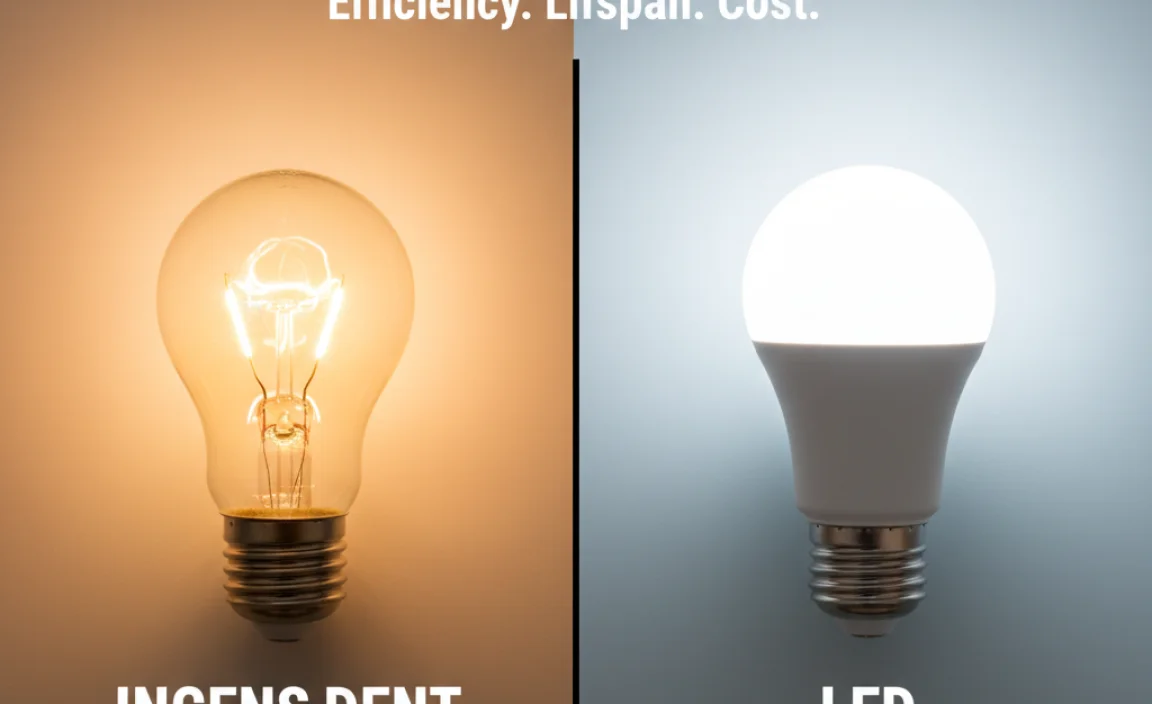
LED lights and traditional light bulbs serve the same purpose, but they differ in many ways. LEDs are more energy-efficient and last much longer. Did you know an LED can last up to 25,000 hours? That’s a big difference compared to standard bulbs, which often last only 1,000 hours. While light bulbs can get hot and waste energy, LEDs stay cool and save on electricity bills. Choosing between them can impact both your wallet and the environment.
Understanding Light Bulbs
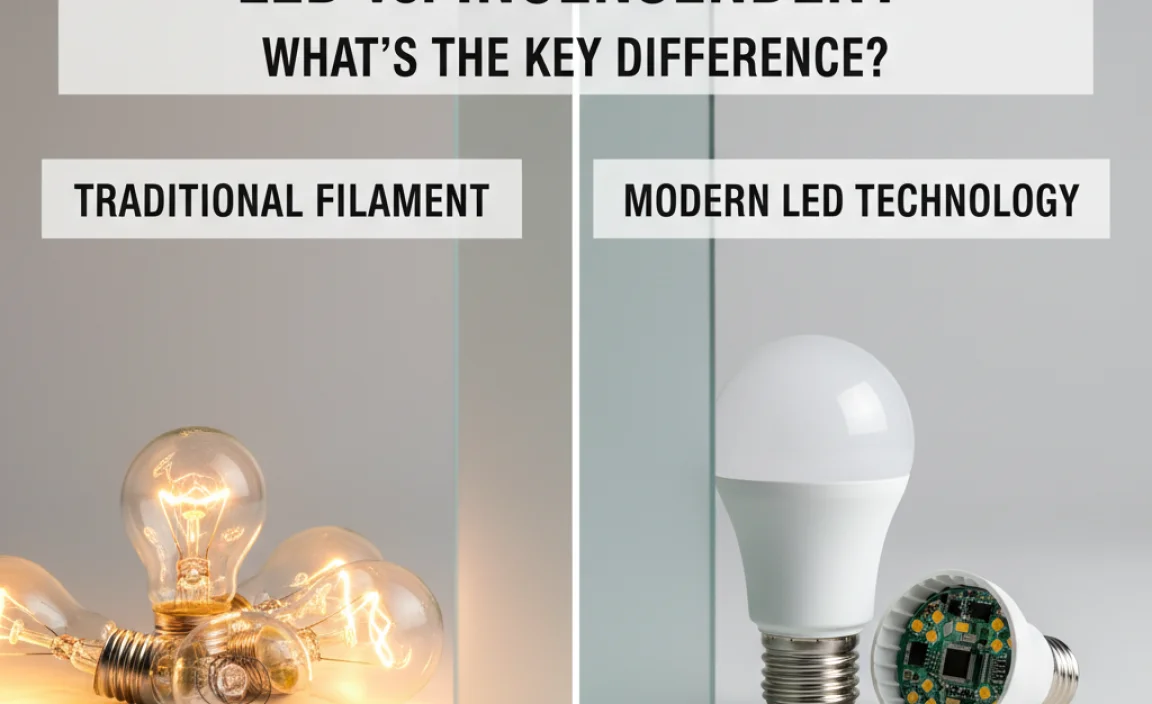
Definition and history of traditional incandescent bulbs. How they work and their common applications.
Incandescent bulbs have been lighting our homes since the late 1800s. These bulbs work by passing electricity through a thin wire called a filament, which then gets so hot it glows. You know, like a golden french fry in the deep fryer! They are commonly found in lamps and ceiling lights. However, they do use more energy and have a shorter life than newer options. Their warm glow is loved, but they’re like that friend who eats all your snacks and leaves you with crumbs!
| Feature | Incandescent Bulbs |
|---|---|
| History | Introduced in the 1800s |
| How They Work | Electricity heats a filament |
| Common Uses | Lamps, ceiling lights |
What are LED Bulbs?
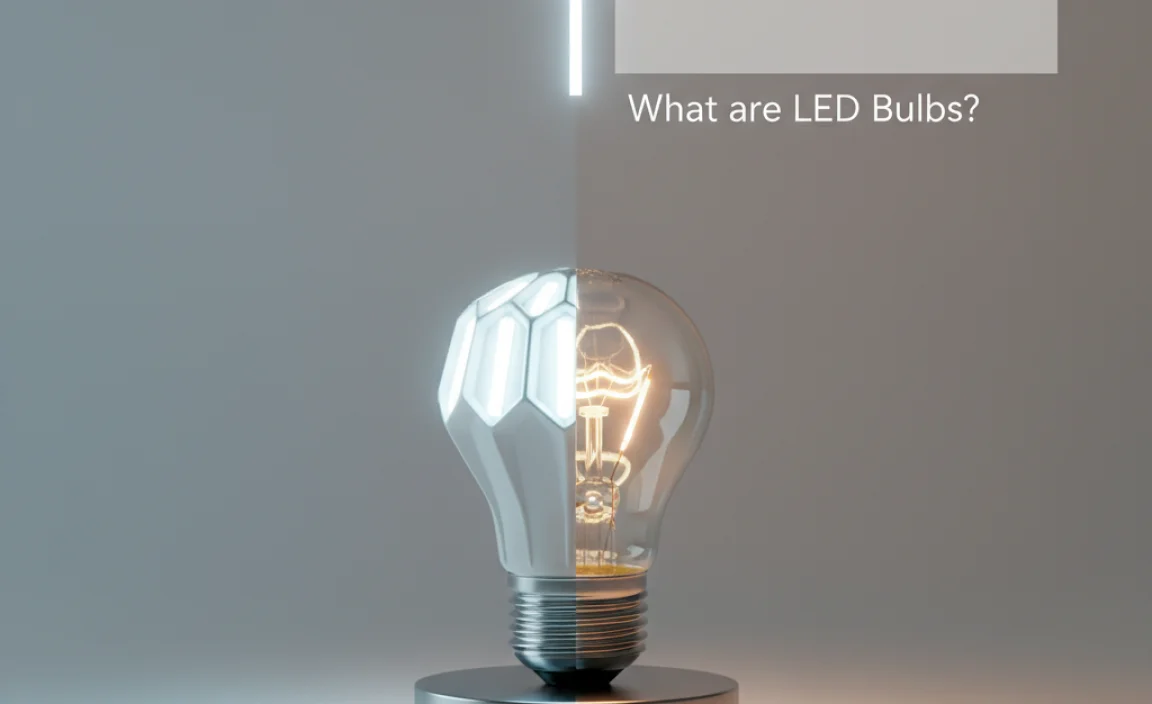
Definition and brief history of LED technology. Explanation of how LED bulbs generate light.
LED bulbs stand for Light Emitting Diodes. They are a modern way to create light. LED technology began in the 1960s. At that time, they were mainly used for indicators, like on electronic devices. Today, they light up homes and streets. LED bulbs create light by passing electricity through a tiny chip. This process generates light efficiently. Compared to regular bulbs, LEDs use less energy and last longer. This makes them a smart choice for many people.
How do LED bulbs work?
LED bulbs work by using a special chip made of semiconductors. They convert electricity into light with very little heat. This innovation helps save energy and cuts costs on electricity bills.
- LEDs use about 75% less energy than traditional bulbs.
- They can last up to 25,000 hours or more!
- LED bulbs are available in many colors and sizes.
Energy Efficiency Comparison
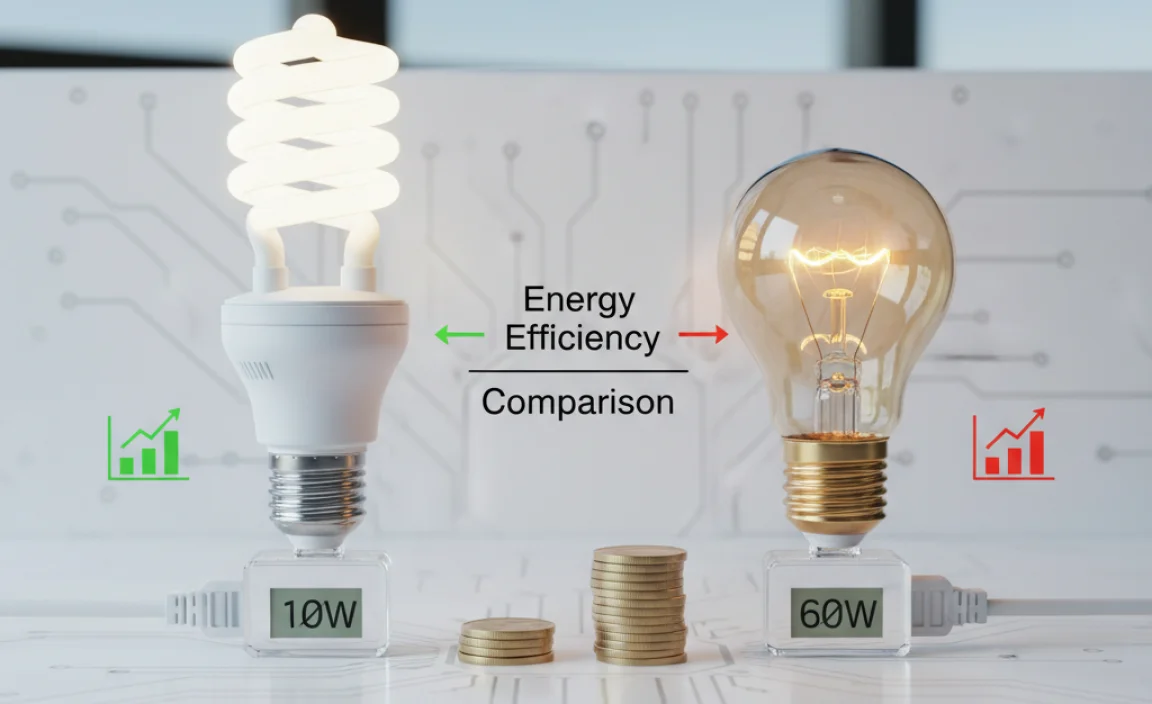
Comparison of energy consumption between LED and incandescent bulbs. Longterm cost savings associated with using LED bulbs.
Switching to LED bulbs is like getting a cozy blanket for your wallet! LED lights use up to 80% less energy than traditional incandescent bulbs. That’s right! What would cost you a small fortune in electricity with incandescents could be a bargain with LEDs. Over time, this energy savings can add up to big bucks. Here’s a fun fact: if you replace just one bulb, you can save around $100 over its lifetime. Wow, who knew lighting could be such a money savior?
| Type of Bulb | Energy Consumption (Watt) | Annual Cost (Approx.) |
|---|---|---|
| Incandescent | 60W | $15 |
| LED | 10W | $2 |
Longevity and Durability
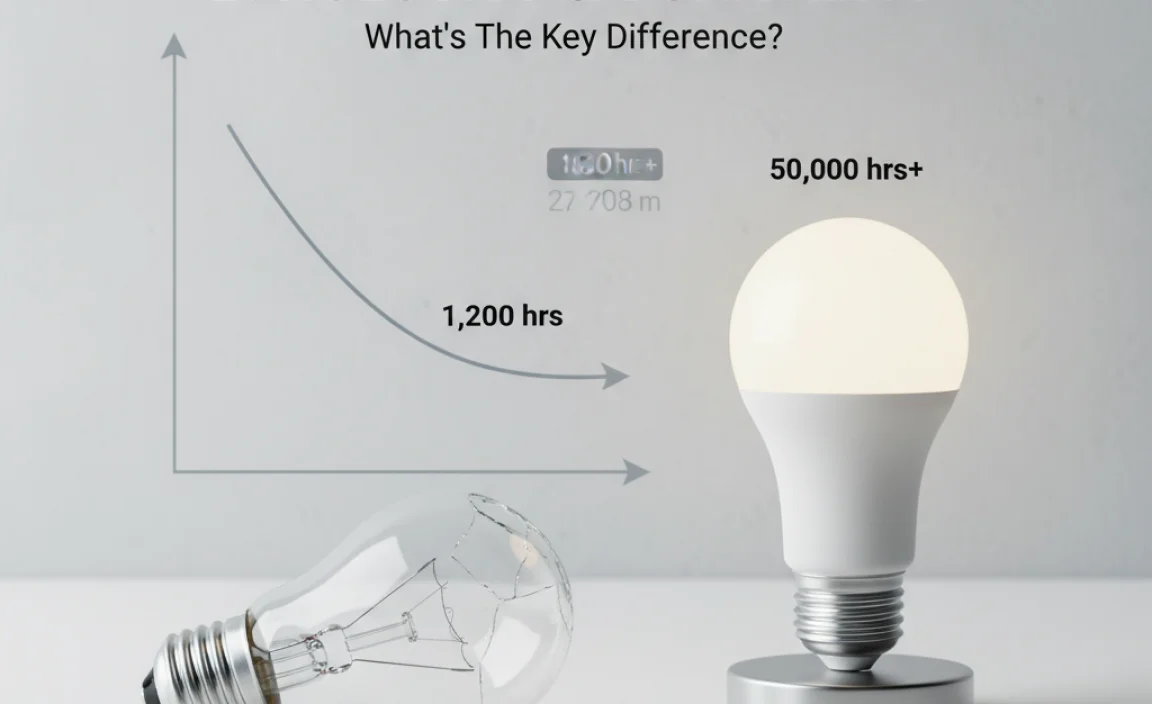
versus traditional light bulbs. Factors contributing to the durability of both types.
LED bulbs can last up to 25,000 hours, while traditional light bulbs only shine for about 1,000 hours. That’s like comparing a tortoise to a hare, but this time, the tortoise wins! LEDs are made with tougher materials, which helps them resist damage. Traditional bulbs fear a little bump, but LEDs laugh in the face of adversity. So, if you want lights that last longer and take bounces like a champ, LEDs are your best buddy!
| Type of Bulb | Lifespan | Durability |
|---|---|---|
| LED Bulb | Up to 25,000 hours | Highly durable |
| Traditional Light Bulb | About 1,000 hours | Less durable |
Light Quality and Brightness
Differences in light output (lumens) and color temperature. Impact on mood and comfort in various settings.
Light output plays a big role in how we feel. Different bulbs produce light in lumps called lumens. For example, an LED may produce fewer watts but shine brighter with more lumens. Next up is color temperature. This tells us if the light is warm, like cozy sunlight, or cool, like a cloudy day. Warmer light can make us feel snug, while cooler light can help us focus. Here’s a fun little table to break it down:
| Type of Bulb | Lumens | Color Temperature |
|---|---|---|
| LED | 800 (similar to a 60W bulb) | 2700K-6500K |
| Incandescent | 800 | 2700K |
Choosing the right bulb can make your room feel bright and happy or calm and cozy. Light affects mood, so pick wisely! After all, who wants to feel gloomy under a disco ball of a light bulb?
Environmental Impact
The ecological footprint of manufacturing and disposal of each type. Benefits of using LED bulbs for reducing carbon emissions.
The way we make and throw away light bulbs matters to our planet. Regular bulbs use more energy to produce. They also create more waste over time. In contrast, LED bulbs have a smaller ecological footprint. They last longer and need less energy. This means lower carbon emissions. By using LED bulbs, we can all help our environment. Here are some key benefits of LEDs:
- Less energy use
- Fewer materials needed
- Longer lifespan
How do LEDs benefit the environment?
Switching to LEDs can cut carbon emissions significantly. Studies show they can save up to 80% more energy than traditional bulbs. This helps fight climate change!
Initial Cost vs. Long-Term Value
Price comparisons at purchase. Evaluating return on investment over time.
Buying light sources can feel like a trip to the candy store. You have your fancy LED lights and the classic light bulbs. At first, LEDs may seem pricey. Imagine paying more to eat your veggies instead of candy! But wait—the real twist comes later. LEDs last much longer and save you cash over time.
| Type | Initial Cost | Average Lifespan | Annual Energy Cost |
|---|---|---|---|
| LED | $10 | 15,000 hours | $3 |
| Light Bulb | $2 | 1,000 hours | $10 |
In the long run, choose the veggie—err, LED! It saves money and keeps your wallet happy. Remember, bright lights do make for fun dance parties.
Application Scenarios
Best uses for traditional bulbs versus LED bulbs. Recommendations for residential and commercial settings.
Traditional light bulbs shine brightly where nostalgia meets warmth. They are best for cozy living rooms or bedside lamps. However, they consume more energy and have a shorter life. On the other hand, LED bulbs are energy-saving champions! They last longer and shine just as bright, making them perfect for busy workplaces or outdoor settings. For your home, use LEDs in high-use areas. In commercial spaces, LEDs save money and keep things bright and cheerful!
| Setting | Best Bulb | Why? |
|---|---|---|
| Living Room | Traditional Bulb | Warmth and comfort. |
| Office | LED Bulb | Energy-efficient and long-lasting. |
| Outdoor | LED Bulb | Bright light with low energy use. |
Conclusion
In summary, LED lights use less energy and last longer than traditional light bulbs. They shine brighter and are better for the environment. If you want to save money and reduce waste, consider switching to LEDs. You can explore more about their benefits online. Making this change can brighten your home and help our planet too!
FAQs
What Are The Main Differences In Energy Efficiency Between Led Bulbs And Traditional Incandescent Light Bulbs?
LED bulbs use much less energy than traditional incandescent light bulbs. This means they help save more money on your electric bill. They also last much longer, so you won’t need to change them as often. This is good for the planet because we waste less. In short, LED bulbs are a smarter choice for saving energy and money!
How Do The Lifespans Of Led Bulbs Compare To Those Of Conventional Light Bulbs?
LED bulbs last much longer than regular light bulbs. You can use an LED bulb for about 15,000 to 25,000 hours. In comparison, a regular bulb lasts only about 1,000 hours. This means LED bulbs save you time and money because you won’t need to change them as often!
What Are The Cost Implications When Choosing Between Led Bulbs And Standard Light Bulbs Over Time?
When you choose LED bulbs, you spend more money at first. But they use less energy, so your electric bill will be lower. LED bulbs last much longer than standard light bulbs, too. Over time, you’ll save money because you won’t need to buy new bulbs as often. So, in the long run, LED bulbs are cheaper!
How Does The Quality Of Light (Color Temperature And Brightness) Differ Between Led Bulbs And Traditional Light Bulbs?
LED bulbs give a bright white or cool blue light, while traditional bulbs shine a warm yellow light. The brightness can be stronger with LED bulbs, making them great for clear visibility. You can also find LED bulbs in different colors for fun. They also use less energy, so they save electricity and last longer.
What Environmental Impacts Are Associated With The Production And Disposal Of Led Bulbs Compared To Traditional Light Bulbs?
LED bulbs are better for the environment than traditional light bulbs because they use less electricity. This means we create less pollution when we use them. However, making LED bulbs can use some special materials that might harm the earth. When we throw away both types of bulbs, traditional ones create more waste. LED bulbs last longer, so we need to replace them less often.








